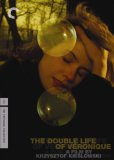| Reviews & Columns |
|
Reviews DVD TV on DVD Blu-ray 4K UHD International DVDs In Theaters Reviews by Studio Video Games Features Collector Series DVDs Easter Egg Database Interviews DVD Talk Radio Feature Articles Columns Anime Talk DVD Savant Horror DVDs The M.O.D. Squad Art House HD Talk Silent DVD
|
DVD Talk Forum |
|
|
| Resources |
|
DVD Price Search Customer Service #'s RCE Info Links |
|
Columns
|
|
|
Double Life of Veronique - Criterion Collection, The
THE MOVIE:
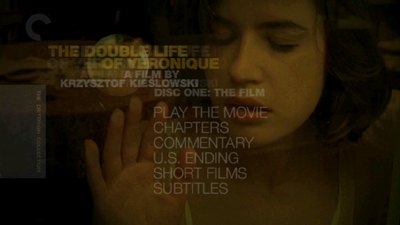
Krzysztof Kieślowski's 1991 feature, The Double Life of Véronique, is a mysterious little movie. While it does tell a story in a semblance of conventional narrative, it's also an emotional jigsaw puzzle, a feat of storytelling agility that puts a lot of trust in its audience. Kieślowski is stingy with the exposition, instead asking us to follow and not to worry about where we are going. Our belief that he will get us somewhere will be its own reward.
Irène Jacob plays Weronika (pronounced Veronika), a Polish girl whose career as a pianist was crushed along with her finger in a car door. She is now in Krakow to pursue singing and by chance ends up earning an important seat on a famous choir. Her artistic pursuit comes with a price, however: it is putting a strain on her relationship with a man she left at home, and it also takes her away from her father, increasing her feelings of anxiety. She has a pervasive sense that something is missing in her life, that she is out of place with the universe.
Cut to a random day on the street of Krakow as a tour bus from France goes through the city square. Looking at the bus, Weronika spots Véronique. Also played by Jacob, Véronique is an exact double for Weronika, something the Polish woman recognizes instantly. The French version doesn't see the other at all, but something has now clicked between them, and they go away from this encounter with a connection, even if one of the pair has not discovered it yet.
Eventually, the story shifts to France and Véronique, a music teacher who shares some of the same concerns about identity as her Polish doppelganger. These become particularly strong after certain events happen to Weronika. A phantom pain is beamed across the European borders, and Véronique is possessed with a grief she cannot put a name to. A sensitive woman, this feeling of loss and dissociation forces her eyes open to the world around her, leading to another chance meeting. While Véronique's class watches a marionette show, the teacher and the puppeteer, Alexandre (Philippe Volter), notice one another, and when the performance is over, Véronique can't get this man out of her head. Shortly after, mysterious packages begin showing up in her mailbox, objects that connect her to Weronika for the audience and Alexandre within the story, and the missing element that Véronique has been searching for begins to come into view. This, too, will have an emotional cost.
Irène Jacob is luminous in the picture. She and Kieślowski were amazing for each other. While they were both excellent apart, their other work never quite compared to their combined efforts on Véronique and, a few years later, Red. Just like other famous actor/director couplings like Gong Li and Zhang Yimou, or even De Niro and Scorsese, they draw performances out of each other that no one else can get. As both versions of Véronique, Jacob manages to make them distinctive while giving the two women enough crossover to make it clear they are of the same spirit. It extends beyond the simple change of hairstyle or langauge. It's in how she emotes, how she carries herself. Weronika starts off more eager, given over to the sheer happenstance of living, whereas Veronique is more melancholy in her search. She maybe feels the love of others more distinctly, but by a tragic turn, also feels more alone because of it.
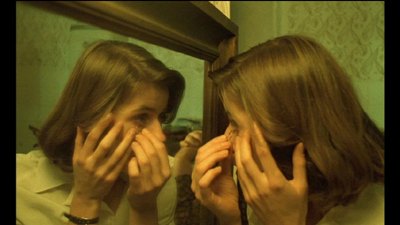
Kieślowski plays tricks with our perceptions in Véronique. The movie opens with a cityscape that is askew, knocking the viewer off balance. As he pulls back, we discover our point of view has been from a little girl looking out either a window or a kind of skylight, and we're unsure if what we saw was a reflection or the real thing, and even if it was right-side up or upside down. Later in the movie, we look at the world as it passes us in bus windows, imperfections in the glass causing pieces of the landscape to go in and out of distortion, or peering through a clear marble that has stars inside, casting a dreamy glow on the world. Similarly, Véronique's paramour is a puppeteer. When he makes two dolls that look like her and shows her how to manipulate them, it's almost like he is giving her the key to her own destiny, showing her how to be more active in her own life; at the same time, it has ironic results, as the appearance that he may embody the unseen force that wishes to take control (bringing the two Véroniques together or keeping them apart?) has the polarizing effect of pushing Véronique away. Even here, the meaning is purely down to how it strikes you. One doll is being brought to life, the other lays dormant on the table. What does the absence of one half of the equation mean for the identity of the other? Like the many images that double and mirror one another in Véronique, would they have had the same significance if shown all alone?
Though The Double Life of Véronique revels in the unexplained, it's never pretentiously obtuse. The master's touch that Krzysztof Kieślowski gives to the film is to invoke our power of intuition. He is an expert at showing and not telling, but showing us in a way that makes us feel the events rather than intellectualize them. The final shots of The Double Life of Véronique are only a couple of snatched, silent moments. It doesn't put the entire picture into a little box and hand it back to us, telling us everything that the story meant, but yet we somehow walk away with a full sense of those things anyway. It's an experience you never forget, and it's why fans of the film have been so eager to finally see it released on DVD. Like the best memories from important times in our life, to relive and reexamine what Weronika and Véronique go through reignites those feelings and reaffirms the power of human instinct in our interactions with the people around us and, most of all, ourselves.
THE DVD
Video:
There has been much discussion over the years about the image quality of existing prints of The Double Life of Véronique, and there is already much debate comparing this new Criterion edition to those from other regions. (If you don't believe me, check the DVD Talk forums.) I know when I saw the film on video years ago, it was extremely orange, and I think you can get a taste of what has previously passed as acceptable from the full-frame alternate ending on disc 1 and the scenes cut into one of the bonus documentaries.
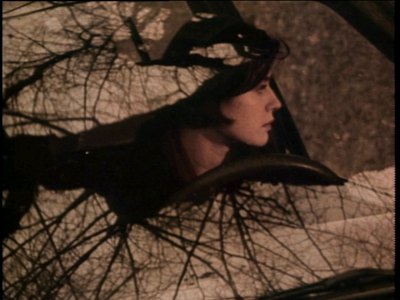
A shot from the Alternate Ending
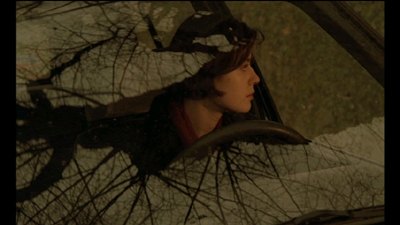
Restored Ending
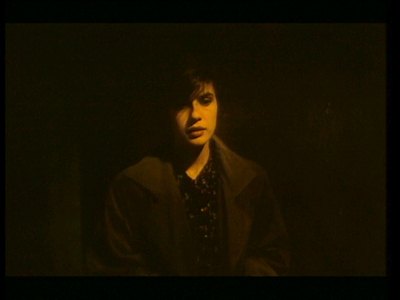
Clip from Documentary
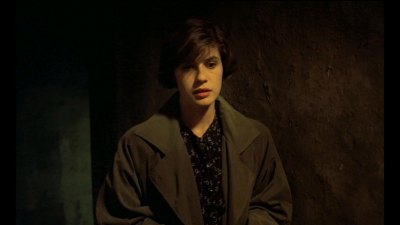
Restored Image
I don't know. I was not there for the original authoring process, I can only go by my eyes, and Criterion's new transfer, mastered at a 1.66:1 aspect ratio, looks pretty damn good to me. There are lots of bright color schemes in The Double Life of Véronique, including the previously mentioned orange--which it turns out was meant to actually be a yellow or gold-- and pretty neon greens. The colors really come to life on this DVD, and I was very pleased to see the film at long last in a clear, vivid format. From the interview with cinematographer Slawomir Idziak on disc 2, which is matched with actual clips from this new transfer, it's quite clear this DVD looks as intended.
Sound:
The stereo mix comes with the original French and Polish audio track and brand-new English subtitles. It sounds fantastic. Check the choral scenes where Weronika performs. The music is awe-inspiring.
Extras:
On the main disc, in addition to the movie, there is a feature length commentary by regular Kieślowski commentator Annette Insdorf. It is an informative explanation of the movie, with Insdorf working shot by shot to question and unravel the riddles the director has given us, as well as explaining the larger political and social background the stories play against. She also contextualizes Véronique in terms of the biography and oeuvre of the filmmaker. Outside the movie, there is the alternate ending that Miramax pushed into the U.S. edition of the film, a completely unnecessary attempt to make the finish of the movie hit us dumb Americans a little harder.
Three of Kieślowski's short documentaries from the '70s and '80s illustrate how he had a similarly intuitive approach to dealing with real subjects as he did fiction. These movies are Factory, Hospital, and Railway, each examining the regular operations of their title subjects. Along with these we get the 1958 short The Musicians by Kieślowski's mentor Kazimierz Karabasz, and following The Musicians with Factory makes the influence of the teacher immediately evident. Kieślowski and Karabasz have a similar knack for editing to juxtapose images against one another for an ironic, enlightening effect. In total, these four movies run about an hour.
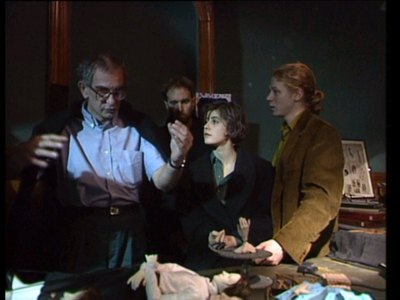
Disc 2 is entirely made up of Kieślowski-related supplements. There are two main documentaries. The first is one from 1991, Kieślowski - Dialogue. This 52-minute program is essentially one long, involved conversation with the director, illustrated with scenes from the movie and on-set footage of Kieślowski working with his crew and Jacob. The second was a half-hour film, 1966-1988: Kieślowski, Polish Filmmaker, made in 2005 that looks at Kieślowski's progression from documentarian to fiction-based film director, all the way through the Decalogue and how it informed what would come to be known as the final phase of his creative life, beginning with The Double Life of Véronique. Taking its cue from one of the thematic elements of Véronique, the compilers are showing the invisible threads that connect every aspect of the artist's filmography.
The rest of disc 2 is nearly an hour of new interviews with three of Kieślowski's main collaborators on The Double Life of Véronique: cinematographer Slawomir Idziak, composer Zbigniew Preisner, and Irène Jacob. All three discuss how they came to know Kieślowski and the process of working with him. Idziak's portion has the added interest of showing many Polaroids from the set of Véronique, and he talks at length about that controversial color scheme.
After watching all the extras on DVD 2, you will feel as if you have a greater understanding of Kieślowski's vision. All the information provided leads us closer to his intention and shows how the creation of The Double Life of Véronique was an extension of its internal ponderings.
The two DVDs come in a gorgeous foldable case. Its split image of Irène Jacob is a playful use of design to illustrate the theme of dual lives. There is also a nice cardboard slipcase big enough to hold the DVD case and the bonus book. This book is squarebound, 64-pages in length, and between its covers, you will find lovely photos from the movie and four essays.
FINAL THOUGHTS:
When a reviewer at this site ranks something as belonging in the DVD Talk Collector Series, it's intended to signify that he or she feels that no movie library should be without the package the title is being bestowed upon. The two main factors for deciding this are the enduring quality of the film in question and whether or not the manufacturers use the DVD technology to the fullest advantage. The Double Life of Véronique easily qualifies in both categories. The movie digs into its viewer and takes root, and it will draw you back again and again. The more you watch it, the more you will like it, and Criterion's new two-disc set opens up the artistic endeavor to reach new levels of understanding. A bravura performance from beginning to end.
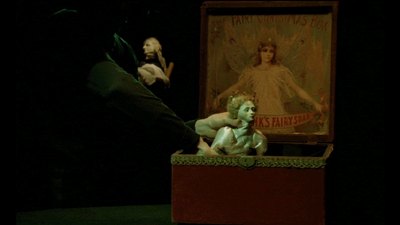
Jamie S. Rich is a novelist and comic book writer. He is best known for his collaborations with Joelle Jones, including the hardboiled crime comic book You Have Killed Me, the challenging romance 12 Reasons Why I Love Her, and the 2007 prose novel Have You Seen the Horizon Lately?, for which Jones did the cover. All three were published by Oni Press. His most recent projects include the futuristic romance A Boy and a Girl with Natalie Nourigat; Archer Coe and the Thousand Natural Shocks, a loopy crime tale drawn by Dan Christensen; and the horror miniseries Madame Frankenstein, a collaboration with Megan Levens. Follow Rich's blog at Confessions123.com.
|
| Popular Reviews |
| Sponsored Links |
|
|
| Sponsored Links |
|
|
| Release List | Reviews | Shop | Newsletter | Forum | DVD Giveaways | Blu-Ray | Advertise |
|
Copyright 2024 DVDTalk.com All Rights Reserved. Legal Info, Privacy Policy, Terms of Use,
Manage Preferences,
Your Privacy Choices | |||||||









